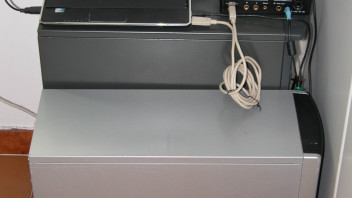In an attempt to bring the signal down and check out if the strong short-term variability is due to internal noise, radiations or some sort of external electromagnetic interference, today I added a lot of shielding in the form of old 3.5" hard disks, computer cases, etc around the Geiger counter, not having lead bricks at disposal.
The GC is in the middle of the black case shown in the photo below, inside a tin-plated steel container, in turn inside a "brick cave" composed of hard disks. Behind the black computer case lie four thin steel layers of 0.4~0.7mm thickness. Having run out of dense materials, The empty space inside the computer case was filled with other material like paper. After I shoot this photo I added another empty computer case to the left, also filled with books/paper.

The overall signal decreased appreciably, but the general behavior didn't. Since the entire assembly is basically a multi-layer Faraday cage I think it can be relatively safely assumed that external EM interference isn't driving those changes.
Yet, despite all the effort and having added at least 15 mm of steel (excluding other materials, although it's hard to quantify their actual contribution) on all sides, I could only get on that location to about 50 CPM, from the ~60 CPM I was previously getting with just the static-free wrapping in the 0.75mm copper tube (in turn down from the initial 80-85 CPM when the counter was exposed to the environment in the same location).


The noise-like behavior appears to have somewhat decreased, but I'm not sure / not clear yet if proportionally to the decrease in overall signal.
It would be nice to check out the response with lead bricks of known properties and size, but at an estimated cost of 4-5 euro/Kg in the best case scenario, a suitable brick cave to attenuate most radiations below at least 1500 keV is going to cost a small fortune that would probably be best invested elsewhere.
I think I'll leave it like this for at least 2 days to check out for the Geiger's long term behavior, then put it out again of the entire assembly and verify that the periodic signal is still there. After that, I think I will be out of ideas for the time being besides doing actual experimentation. The periodic signal still remains a mystery.
